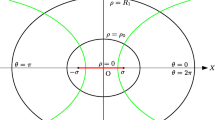Abstract
Since the stability of the method of fundamental solutions (MFS) is a severe issue, the estimation on the bounds of condition number Cond is important to real application. In this paper, we propose the new approaches for deriving the asymptotes of Cond, and apply them for the Dirichlet problem of Laplace’s equation, to provide the sharp bound of Cond for disk domains. Then the new bound of Cond is derived for bounded simply connected domains with mixed types of boundary conditions. Numerical results are reported for Motz’s problem by adding singular functions. The values of Cond grow exponentially with respect to the number of fundamental solutions used. Note that there seems to exist no stability analysis for the MFS on non-disk (or non-elliptic) domains. Moreover, the expansion coefficients obtained by the MFS are oscillatingly large, to cause the other kind of instability: subtraction cancelation errors in the final harmonic solutions.
Similar content being viewed by others
References
Bogomolny A (1985) Fundamental solutions method for elliptic boundary value problems. SIAM J Numer Anal 22: 644–669
Chen, CS, Karageorghis, A, Smyrilis YS, (Eds) (2009) The method of fundamental solutions—a meshless method. Dynamic Publishers, Inc., USA
Christiansen S (1976) On Kupradze’s functional equations for plane harmonic problems. In: Gilbert RP, Weinacht R (eds) Function theoretic method in differential equations. London, Research Notes in Mathematics, vol. 8, pp. 205–243
Christiansen S (1981) Condition number of matrices derived from two classes of integral equations. Math Methods Appl Sci 3: 364–392
Davis PJ (1979) Circulant matrices. Wiley, New York
Davis PJ, Rabinowitz P (1984) Methods of numerical integration, 2nd edn. Academic Press, New York, p 315
Gradshteyan IS, Ryzhik ZM (1965) Tables of integrals, series and products. Academic Press, New York
Katsurada M (1989) A mathematical study of the charge simulation method II. J Fac Sci Univ Tokyo, Sect IA Math 36: 135–162
Katsurada M (1990) Asymptotic error analysis of the charge simulation method in a Jordan region with an analytical boundary. J Fac Sci Univ Tokyo, Sect IA Math 37: 635–657
Katsurada M (1994) Charge simulation method using exterior mapping functions. Jpn J Ind Appl Math 11: 47–61
Kitagawa T (1991) Asymptotic stability of the fundamental solution methods. J Comput Appl Math 38: 263–269
Kupradze VD (1963) Potential methods in elasticity. In: Sneddon JN, Hill R (eds) Progress in solid mechanics, vol III. Amsterdam, pp 1–259
Li X (2005) On convergence of the method of fundamental solutions for solving the Dirichlet problem of Poisson’s equation. Adv Comput Math 23: 265–277
Li ZC (1998) Combined methods for elliptic equations with singularities, interface and infinities. Academic Publishers, Dordrecht
Li ZC (2009) The method of fundamental solutions for annular shaped domains. J Comput Appl Math 228: 355–372
Li ZC (2009) The fundamental solutions for Laplace’s equation with mixed boundary condition. In: Chen CS, Karageorghis A, Smyrlis YS (eds) The method of fundamental solutions—a meshless method, Chap 2. Dynamic Publishers, Inc., USA, pp 29–49
Li ZC, Chien CS, Huang HT (2007) Effective condition number for finite difference method. J Comput Appl Math 198: 208–235
Li ZC, Lu TT, Hu HT, Cheng AH-D (2008) Trefftz and collocation methods. MIT, Southampton
Li ZC, Mathon R, Sermer P (1987) Boundary methods for solving elliptic problems with singularities and interfaces. SIAM J Numer Anal 24: 486–497
Lu TT, Hu HY, Li ZC (2004) Highly accurate solutions of Motz’s and cracked-beam problems. Eng Anal Bound Elem 28: 1378–1403
Oden JT, Reddy JN (1976) An introduction to the mathematical theory of finite elements. Wiley, New York
Smyrilis YS, Karageorghis A (2001) Some aspect of the method of fundamental solutions for certain harmonic problems. J Sci Comput 16: 341–371
Smyrilis YS, Karageorghis A (2004) Numerical analysis of the MFS for certain harmonic problems. ESAIM: Math Model Numer Anal 38: 495–517
Author information
Authors and Affiliations
Corresponding author
Additional information
This paper is dedicated to Professor Robert Schaback on the occasion of his 65th birthday.
Partial results were presented at the first International Workshop on the Method of Fundamental Solutions (MFS2007), Ayia Napa, Cyprus, 11–13 June 2007. The work of J. Huang is supported by the National Natural Science Foundation of China (10871034).
Rights and permissions
About this article
Cite this article
Li, ZC., Huang, J. & Huang, HT. Stability analysis of method of fundamental solutions for mixed boundary value problems of Laplace’s equation. Computing 88, 1–29 (2010). https://doi.org/10.1007/s00607-010-0081-4
Received:
Accepted:
Published:
Issue Date:
DOI: https://doi.org/10.1007/s00607-010-0081-4
Keywords
- Stability analysis
- Condition number
- Effective condition number
- Method of fundamental solutions
- Mixed boundary problem
- Motz’s problem
- Laplace’s equation




